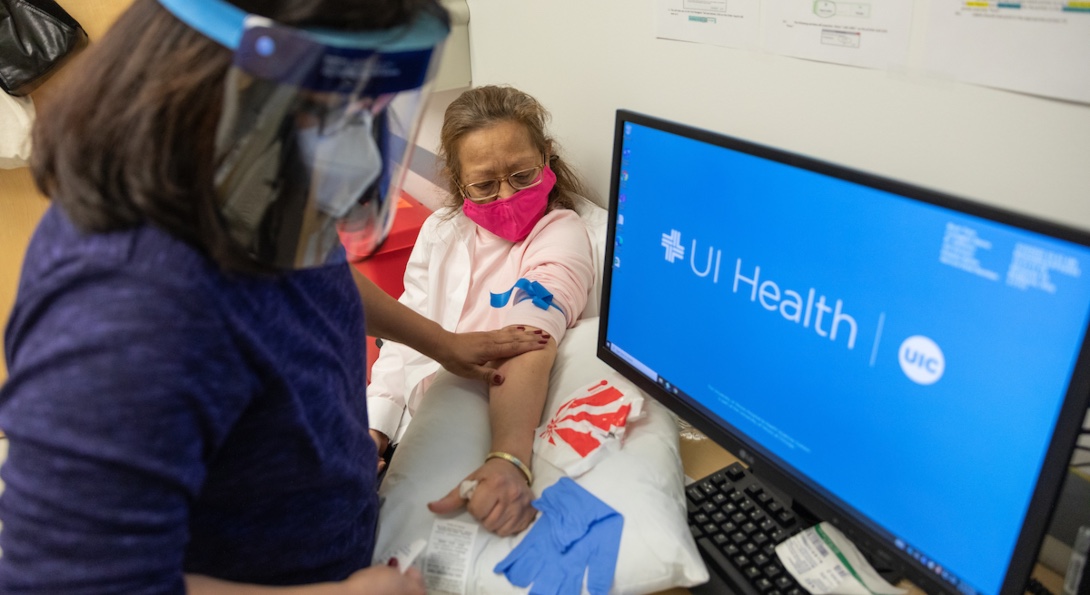In it for the long haul

With as many as half of COVID-19 patients have lingering, disabling symptoms, UIC public health leaders and clinicians are now part of an ambitious national effort to figure out why—and how to help.
Story text
When Blair Rohrbach tested positive for COVID-19 in September 2020, she worried. She has a long history of illness, and in 2019, received a liver transplant. Now, she takes medication to suppress her body’s natural defenses. “I thought, ‘I’m immunocompromised,’” she says. “I was nervous I was going to wake up in the middle of the night and not be able to breathe.”
Fortunately, that never happened. Rohrbach wasn’t hospitalized for COVID-19; her 99-degree fever lasted only a day, and her blood oxygen level, tested at home regularly, stayed safely above 95%. The tickle in her throat and mild cough quickly faded.
Other problems remained. She slept nine to 10 hours a night, but her exhaustion lingered; her focus scattered. The migraines she’d had as a teen returned and lasted days. They came with auras—streaks across her vision, as if she stared at the sun too long—making it difficult to see or drive. Her anxiety and depression, which she’d been managing, flared.
“Two weeks went by, and I was still feeling crummy. I thought ‘this might last for a while,’” she says. “Then it never went away.” More than a year later, she’s still coping with her symptoms.
Rohrbach, 38, is one of the estimated 10% to 50% of people who have long-term complications with COVID-19. Medical experts aren’t sure why some, including those who weren’t severely ill to begin with, develop what’s often called long COVID-19. They’re searching for answers and treatments. Right now, Rohrbach is in both physical therapy and psychotherapy and takes antidepressants and antianxiety medications. Still, she struggles.
“There are points where I’ve felt totally hopeless, like, ‘when am I going to feel better?’” she says.
Much about the disease remains mysterious. Now, in partnership with patients like Rohrbach and leaders in hard-hit communities, UIC scientists aim to decode long COVID-19’s secrets and determine the best ways to support those affected by it, especially in vulnerable communities.
Beginning this year, UIC researchers in Chicago and Peoria are embarking on a four-year, $22-million project called ILLInet RECOVER, which is funded by the National Institutes of Health as part of the national Researching COVID to Enhance Recovery initiative. The study will track people with long COVID-19—or, as researchers refer to it, post-acute sequelae of SARSCoV- 2 infection (PASC)—over time, at UI Health in Chicago and OSF St. Francis Medical Center in central Illinois. OSF St. Francis Medical Center is an affiliate of the College of Medicine Peoria that provides clinical training to medical students, residents and fellows.
The results will illuminate this new disease and may shed light on other poorly understood chronic conditions, especially those that occur after viral illnesses, says Dr. Jerry Krishnan, UIC associate vice chancellor for population health sciences, professor of medicine and public health, and ILLInet RECOVER’s contact principal investigator. What’s more, thanks to UIC’s pioneering approach of community engagement, the project will continue shifting the way medical research is conducted—and utilized.
“This isn’t going to be science designed in a meeting room,” Krishnan says. “This is science in partnership with people, churches, organizations and small businesses in the communities where we live.”
A wide-ranging, puzzling illness

In August 2021, UIC launched a Post-COVID Clinic bringing together experts in lung, kidney and immune system health, among other specialties. Some long COVID-19 patients have residual coughs, trouble breathing or even require oxygen, says Krishnan, a pulmonologist. Fatigue and cognitive issues like Rohrbach’s are common. Other common symptoms include sleep disorders, gastrointestinal symptoms, fast or pounding heartbeat, muscle or joint pain and dizziness when standing. Mood disorders like anxiety and depression can develop or worsen.
Early in the pandemic, UIC physician-scientists realized COVID-19 disproportionately affected certain people, including communities of color. That’s largely due to social determinants of health—aspects of people’s environments influencing their well-being, says SPH alum Dr. Heather Prendergast, Executive Master of Healthcare Administration ’19, MS in Clinical and Translational Sciences ’14 and MPH in Health Policy and Administration ’07, associate dean of clinical affairs and professor of emergency medicine at UIC and an ILLInet RECOVER co-principal investigator.
For instance, limited access to fresh food in some neighborhoods leads to hypertension and other comorbidities; essential workers who couldn’t stay home during the pandemic were more frequently exposed to the virus; and multigenerational households risked spreading the virus to the oldest and most vulnerable.
Similar factors may influence risk of long COVID-19, but because some infected people never interacted with the medical system, it’s hard to draw conclusions. “For every person who came to the hospital, there were probably several others who waited out their symptoms at home,” Prendergast says. Perhaps they didn’t have a trusted doctor, or couldn’t get time off work. Or, when they noticed vague symptoms like fatigue and brain fog months later, they might not connect them to the prior illness.
Rural communities are also vulnerable to acute and long COVID-19, for reasons both similar and different, says UIC’s Dr. Sarah Stewart de Ramirez, associate professor of emergency medicine and director of equity innovation medicine at the University of Illinois College of Medicine Peoria, medical director of population health at OSF HealthCare and co-principal investigator on the trial. Population density isn’t an issue, but poverty and limited access to health care and social services are exacerbated by physical distance.
In any setting, stress and a lack of support that allows people to rest and recover could contribute to ongoing symptoms. Other potential risk factors for long COVID-19 are more biological, Krishnan says. The strain of virus—the original SARS-CoV2 or a variant like Delta or Omicron—might affect your chances of developing long-term complications. Some people’s immune systems also seem predisposed to overreact, turning on the host instead of simply vanquishing the virus.
Partnerships for progress
Truly understanding how the disease works requires reaching deep into affected communities. That’s where partners like Bright Star Community Outreach, in the city’s south-side Bronzeville neighborhood, come in, says Prendergast, who’s overseeing ILLInet RECOVER’s community engagement efforts. People of color have legitimate reasons to be skeptical of medicine in general and research in particular, says Pastor Chris Harris of Bright Star Church Chicago, founder and CEO of Bright Star Community Outreach. Not only is there a history of abusing and neglecting study participants, few projects have dedicated resources to addressing problems revealed in their data.
“Historically, researchers have come in and treated Black and brown communities like lab rats,” he says. “They come and get data and then leave, without leaving any dollars to change or move the needle.”
Harris has been working for years to address these issues and earn trust on both sides. He’s built nationally recognized programs addressing the trauma of violence, received federal grants to conduct research and hosts an online show called “Clergy & Clinicians,” where he interviews Black medical professionals about relevant health topics.
COVID-19 hit his community hard. He knows more than 90 people who have died, so he jumped into action. His mission is to educate and protect his congregation by teaching what he calls “the three Vs,” virus, vaccine and variants. Getting involved in ILLInet RECOVER was an easy choice.
“A lot of times people do things to the community, or they think they’re doing things for the community, when you’re supposed to do things with the community,” Harris says. “Let the community lead this conversation. And that’s the exact approach they are taking.”
Community partners are integral to every step, Prendergast says: “We want them to have a voice and a seat at the table.”
Partners will offer input on study materials, including both recruitment information and survey questions. That way, they can gather information helpful to community leaders too, not just what’s in the federal protocol. They will spread the word about the study and the need for participants through their communication channels. UIC will also hire community members to conduct parts of the study. Partners will also have a role in reporting results—including information about risks and potential treatments—back to their communities.
Other partners include Chicago Urban League, Illinois Unidos, Central Illinois Friends, Tri-County Urban League, Friendship House and Peoria City/County Public Health. In Peoria these relationships will help eliminate uniquely rural barriers to participating in the study—for instance, reducing travel time. And, they’ll bring public health and medicine together, paying dividends in this pandemic and the next one.
“You don’t find a lot of large trials pushing forward the biological level of discovering and defining a disease at the same time as trying to understand how we best engage vulnerable communities,” Stewart de Ramirez says. “Those take different sets of skills and different attention to detail. But they’re both essential to the future of scientific research.”
A better future, together
UIC’s immersion in and care for underserved communities is likely one reason the institution was chosen as the only Illinois site for RECOVER, says Krishnan, who played a key role in securing the grant. The university’s excellence across fields, from public health to frontline clinicians to behavioral science, also put it a step ahead. The study began enrolling patients in January.
Participants complete a survey, brief physical exam and have lab tests every three to six months for two years. Those results will be provided to participants and, with permission, their health care providers. Individuals and clinicians can go to the ILLInet RECOVER website, illinet.org, for more details about participating or referring patients.
Besides Krishnan, Prendergast and de Ramirez, other principal investigators include Dr. Wayne Giles, dean of the UIC School of Public Health; Dr. Bellur Prabhakar, senior associate dean for research and professor of microbiology and immunology at UIC; and Dr. Terry Vanden Hoek, professor and head of emergency medicine at UIC and chief medical officer at UI Health. Additional co-investigators are Dr. Robin Mermelstein, director of SPH’s Institute for Health Research and Policy, and Dr. Richard Novak, the Harry F. Dowling Professor of Medicine and chief of the division of infectious diseases.
In addition to the brightest scientific minds, a largescale study like this takes precise coordination. Leading these efforts is study chair Dr. Jonathan Klein, UIC associate vice chancellor for research, Savithri and Samuel Raj Professor and executive vice chair of pediatrics. The role involves orchestrating complex logistics, including call centers, exam and lab operations and electronic records, and transporting biospecimens like blood samples where they need to be. And, it all must be done quickly, without sacrificing patient care. “The urgency of getting things up and running at all the sites as soon as possible is very much on everybody’s mind, because we really need answers in the pandemic,” Klein says.